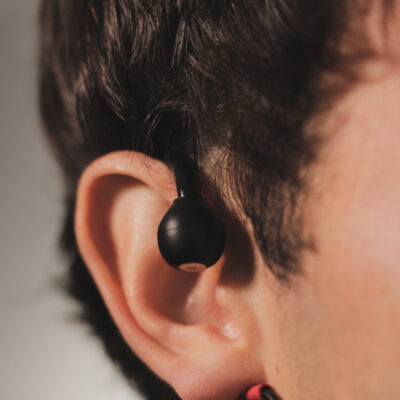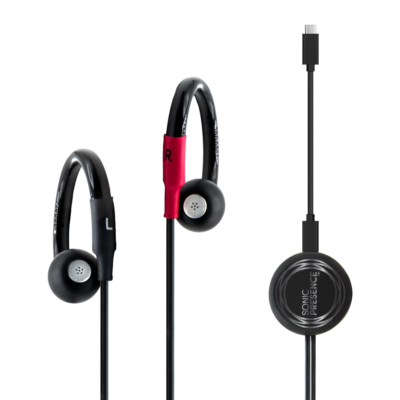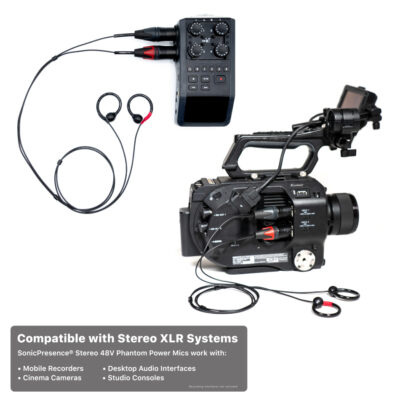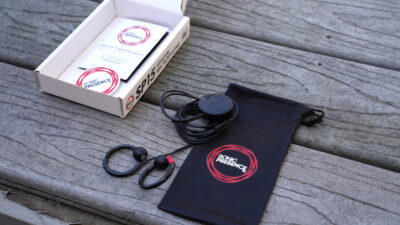Binaural Microphone Review: Sonic Presence SP15C and SP15 PRO
In this binaural microphone review, expert sound designer/audio post pro Frank Verderosa evaluates the Sonic Presence SP15C and SP15PRO.
As a commercial audio mixer, I have suggested to my clients for years that they take advantage of the world of increasingly headphone-consumed content. Buzzwords like “spatial audio” and “3D sound” have finally gained traction, and the demand for audio that surrounds us in our headphones is up dramatically! Companies like Dolby with Atmos, and Apple’s own Spatial Audio, are leading the charge on production and playback, but what about recording?
As an audio engineering student in the late 80s, I vividly remember sitting at an AES booth listening to the Dimension Holophonics sound effects library demo. It was a series of ambisonic sound effect recordings that blew my mind. Forget about left and right. Now we’re experiencing front, back, up and down (does anyone reading this remember the old paper bag over the head or haircut trick?).
I have craved the ability to record my own binaural sound effects on the go. The high-end dummy head mics can get a bit pricey – and cumbersome.
Two Takes on Binaural Mics
That’s where the Sonic Presence comes in, with two models of binaural microphone: the SP15 Pro and the SP15C. The only difference between the two models is how they connect. The SP15 Pro is XLR, while the SP15C is a USB C connection for mobile devices on the go. Which one is for you depends on what and how you’re capturing audio.
In simple terms, it’s a microphone disguised as headphones that make YOU the dummy head. (Hey… wait a minute!!) You get a pair of mics mounted on ear hooks that rest just outside your ear canal. The SP15C comes ready to plug into any USB C device (iPad Pro, Android phones/tablets, and computers). A simple USB-to-lightning adapter will get you into your iPhone or older iPads. The Pro version is ready to connect to any mixer or interface with at least two available XLR inputs.
The next step? Nothing. Just hit “record.”
In Use
When I was sent these mics to review, I had the good fortune of having a massive thunder and lightning storm roll through. I sat on my front porch and back deck for a long time waiting for just the right thunder claps- and I got plenty!
I simply recorded the Sonic Presence mics into my iPhone 11’s video recorder. Next, I went back inside and gave it a listen on my AirPod Pros. I was floored. Not because I was hearing this immersive storm experience, where the rich bass of the rolling thunder echoed in the distance- but because I could close my eyes and SEE the drainpipe that I was hearing. Just to my left, the rain flowed through the gutters making a metallic trickle sound that I could literally point to in the audio field. When cars drove by on the flooded streets, I could visualize the pass-by, just like in those old Dimension Holophonic recordings.
SP15C and Pro vs Iphone 11 Mic from Frank Verderosa on Vimeo.
I now carry the SP15C with me everywhere, because as a sound designer I never know what interesting audio I’m going to want to capture. On a commuter train into NYC, I let the audio roll into my iPhone’s Voice Memo app as the conductor came through clicking her ticket puncher from seat to seat. On playback, I could localize every click— and when the PA announcer played back over my headphones, I had to take them out to see if it was a live announcement or a recorded one!
Coming out of lockdown, a new building was going up across the street from the studio I work for. I decided one day to stop and record it – first with the built-in mics in my iPhone 11, and then with the SP15C. It is a night and day difference. At one point, a couple of workers started speaking just to my right, and I always do a double take on playback. The clarity of the audio and the range picked up is incredible! I took the mics with me on a family trip to Philladelphia, and captured some ambience as we walked around the city. At one point a car slowly rolled by with its subwoofers rumbling the ground. That all got picked up extremely well.
I wanted to see how well they handle really heavy SPLs, so I took them to see a band at The Palladium Times Square. Once again I compared just my phone to the SP15C. The SP15C never distorted and had no problem capturing the lowest lows and the brightest highs. On playback, I can localize the people behind me talking and cheering!
Value Proposition
I did not expect this level of quality from the SP15C for $149! (The SP15 Pro retails for $249.) They fold up like any pair of headphones into their own little pouch, making them a must-have item on my travels. I am quickly and easily amassing my own ambient sound effects library.
One of the things I always struggle with when pulling sound effects is finding a beach scene that reminds me of when I actually go to the beach! Problem solved. I sat in a chair on the Jersey Shore and recorded my own beds of sound effects. Sporadic seagulls with crashing and rolling waves against the jetties – recorded in a way that puts you in the space. And all I needed to go with the mics was my phone.
You can plug these into any recorder that works for you. I have had no problem with video on my iPhone or even just Apple’s Voice Memos app. Keep in mind that when using those apps, some have no gain control. I haven’t found this to be a problem, since I can get the audio into Pro Tools and set it where I need it. There is no knob to adjust gain on the SP15C mic itself, so you need to rely on your device by using an app that lets you control the gain. Otherwise, I would opt for the SP15 Pro, so you have all the gain control you need. Just be careful to perfectly match the two input levels!
The SP15 Pros could be very useful for all sorts of location recording applications, where perhaps the actors or voices are mic’d separately at a distance away while you capture actual location ambience at the same time.
To Be Critical
One thing to be mindful of is wind. I had recorded a nice walk from the studio to Penn Station in NYC… but when I came off the side street onto 7th Avenue, the wind was gusting pretty heavily. Playback was riddled with wind rumble. I think a great add-on from Sonic Presence would be a pair of tiny wind screens to put over the mics, like the ones you see for lavs and other location mics. (Editor’s note: Sonic Presence recommends the Windtech 8801.)
Another thing to watch out for — since you’re the dummy head here — is your position. If you’re recording a friend’s band at a club, and you turn your head to talk to someone, the whole perspective shifts (obviously). So you need to keep steady in those moments. I find that while walking through the forest or the city collecting ambience, those subtle shifts and head turns lend a bit of realism to the scene as people, cars, etc, pan around my head.
In Conclusion
Beyond those minor concerns, I can’t say enough good things about the Sonic Presence microphones as a simple and practical way to capture hassle-free immersive audio for podcasting, radio production, location audio — you name it. These will always be in my bag on the go!
— Frank Verderosa is a mixer, sound designer and composer. He is a Senior Mixer at Digital Arts in New York City. Visit him at https://www.frankverderosa.com/.
Please note: When you buy products through links on this page, we may earn an affiliate commission.











[…] Source link […]
[…] Now we’re experiencing front, back, up and down (does anyone reading this remember the old paperSource…Continue reading at source […]